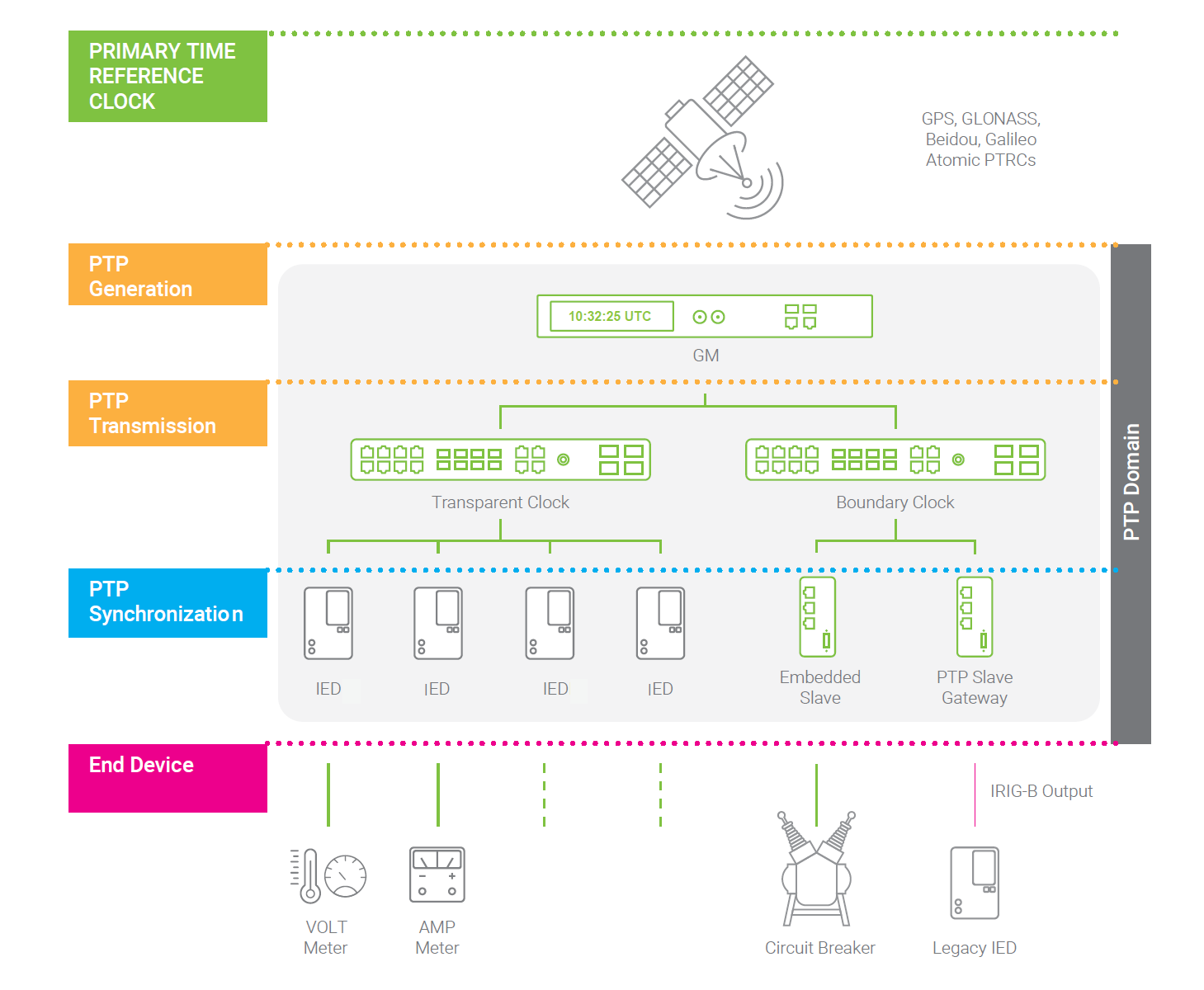Guide to Precision Timing Protocol in Power Substations
Precise time synchronization is essential for the safe and reliable operation of power systems. Network faults can occur at any time, but especially for critical utilities, fault detection and isolation need to be fast and accurate to minimize the risk of damage.
Even under normal operation, the stability and control of power systems depend on coordination and synchronization of various devices and systems, such as generators, transformers, and switches. Precise time synchronization allows for coordinated operation and control of these devices, ensuring grid stability and minimizing the risk of power outages. For renewable energy sources such as solar and wind power, where energy resources are often distributed, time synchronization is particularly important for coordination of multiple sources to maximize their contribution to the grid.
Power grid monitoring and analysis also require precise time synchronization to accurately correlate data from various sources, such as sensors and meters. With event data in the correct sequence, managers can perform real-time and offline analysis of grid performance and faults.
Why use Precision Time Protocol?
Precision Time Protocol (PTP) is a protocol that is used to synchronize clocks in a network to a common time reference. Key features of PTP include:
-
- High accuracy
PTP’s most defining feature is its ability to provide sub-microsecond accuracy, by exchanging hardware timestamped packets between devices. Because packets are timestamped when they enter and leave a device, inaccuracies that arise from software processing time are eliminated. The process doesn’t require additional processing overhead, which can introduce jitter and delay in the time synchronization process. Thus PTP is suitable for applications that require precise timing, such as power systems and industrial automation, as well as for telecommunication networks and financial trading systems. - Dynamic adaptability
PTP is able to dynamically adjust its synchronization rate and algorithm to adapt to changes in network conditions, such as latency or packet delay variation. Accumulated delay calculations are used to provide an accuracy with 1 μs. - Fault tolerance
PTP includes mechanisms for fault tolerance and redundancy, such as backup grandmasters and boundary clocks, to ensure that the network continues to operate in the event of failures or disruptions. - Scalability
PTP can support large-scale networks with thousands of devices, making it suitable for power systems, which have many interconnected devices that require synchronized timing. A single grandmaster clock can synchronize the time of multiple devices on the network, so the cost of deploying and maintaining multiple timing sources is low. - Cost effective
PTP can operate over Ethernet networks, eliminating the need for dedicated timing hardware. Therefore, it is a cost-effective solution to install and to maintain.
- High accuracy
How does PTP work?
The architecture of a PTP network involves a hierarchical system of master and slave clocks. Masters serve as the source of time, distributing the time to different segments, while slave clocks receive PTP messages from masters and adjust their own time to synchronize with the network time. This strata system allows for easier network management and troubleshooting of issues when they arise.
A common substation PTP network includes a grandmaster (GM) clock, boundary clocks (BC) and transparent clocks (TC) as intermediary slaves, and end slave clocks, as depicted in the following figure. Below we will take a deeper look into the features and requirements of each clock type.

The grandmaster clock
Stratum 1 in the PTP hierarchy contains the grandmaster clock, which is the source of accurate time for the entire PTP network. The grandmaster is typically synchronized to a reference (Stratum 0) time source such as a GPS clock. Based on the reference time, it generates PTP messages and distributes them to lower-tier clocks in the network. The reliability of the grandmaster ensures accuracy for the whole system, and redundancy is essential as a fault-tolerant precaution.
As a power-grade grandmaster clock, ATOP NTS7500 incorporates a high-precision GNSS module and PTP hardware support, including for IEEE/IEC 61850 Power Profiles as well as for legacy ones like IRIG-B, BJT, BCD, ST, and ST with checksum. The industrial fanless design, wide operation temperature, and high EMC ensure maximal availability under harsh conditions, while PRP and power redundancy further safeguard the PTP network against failures.
Boundary clocks
Boundary clocks receive time information from the grandmaster clock and act as new masters to redistribute it to other devices in the network. They also perform time stamping and packet forwarding functions. Boundary clocks reduce the load on the grandmaster clock and improve time accuracy by minimizing the propagation delay of PTP messages.
Capacity is an important feature of boundary clocks, as they are often used to connect multiple PTP domains or in complex network topologies. The ATOP RHG9528 and RHG9628 hardware-based boundary clock supplies up to 24 Gigabit ports to handle large numbers of PTP clients with simple architecture, while additional 10G uplinks allow fast transmission to upper level management. Its modular configuration provides flexibility and scalability. Support for multiple profiles ensure compatibility with various PTP devices.
Transparent clocks
Transparent clocks also receive PTP time packets from the grandmaster, but while they measure the propagation delay of PTP messages and compensate for it, they do not modify the PTP messages in any way—they forward the messages transparently between network segments. Transparent clocks are used in large networks with multiple network segments, and provide a way to mitigate the effects of network latency and delay variation.
A good transparent clock, like ATOP EHG9508 and EHG9512, supports multiple network segments to provide accurate time synchronization across large networks. It integrates easily into existing network infrastructure without causing disruption, and its low latency minimizes propagation delay to establish accurate time synchronization.
Transparent clocks calculate link delay time within a network by two methods, end-to-end (E2E) or peer-to-peer (P2P). With E2E, timestamps for delay calculation are collected when the clock receives the time packet from the grandmaster, and when the packet reaches the end of the network. Any other transparent clocks in between simply forward the packet, achieving maximal efficiency. ATOP EHG95xx and EHG96xx series are of this type.
With P2P, timestamps are collected and the delay calculated from each transmission (or hop) between a sequence of transparent clocks. ATOP RHG95xx and RHG96xx series can work as this type of transparent clock, which, compared to E2E, may generate higher loading but also higher accuracy.
Ordinary clocks
The final level in a PTP network is ordinary clocks, or PTP-enabled devices, which are those that receive PTP time packets from the boundary clocks or transparent clocks, and use the information for operation. In a power substation, ordinary clocks can be part of protection relays, meters, switches, and others. They do not pass on the PTP packets to other devices, but may use the time information to control other end devices.
ATOP’s range of PTP-enabled devices are rugged for harsh environments, easy to manage through web UI or dedicated software, and most importantly, cyber secure. The EH9711 managed switch, for example, is compliant with IEC62443-4-2. Security-assuring features include network monitoring with port mirroring and access control with 802.1x, AAA, ACL, and IP Source Guard.
Adopting PTP can help substations achieve highly precise and stable time synchronization, enabling efficient and reliable operation of critical power system applications. To ensure successful implementation of PTP in power substations, one must consider various factors such as clock selection, network architecture, and hardware and software requirements. Reach out to our experts for discussions on your specific project, or read our earlier whitepaper for more in-depth knowledge on PTP.



